15 Birds With Red Beaks
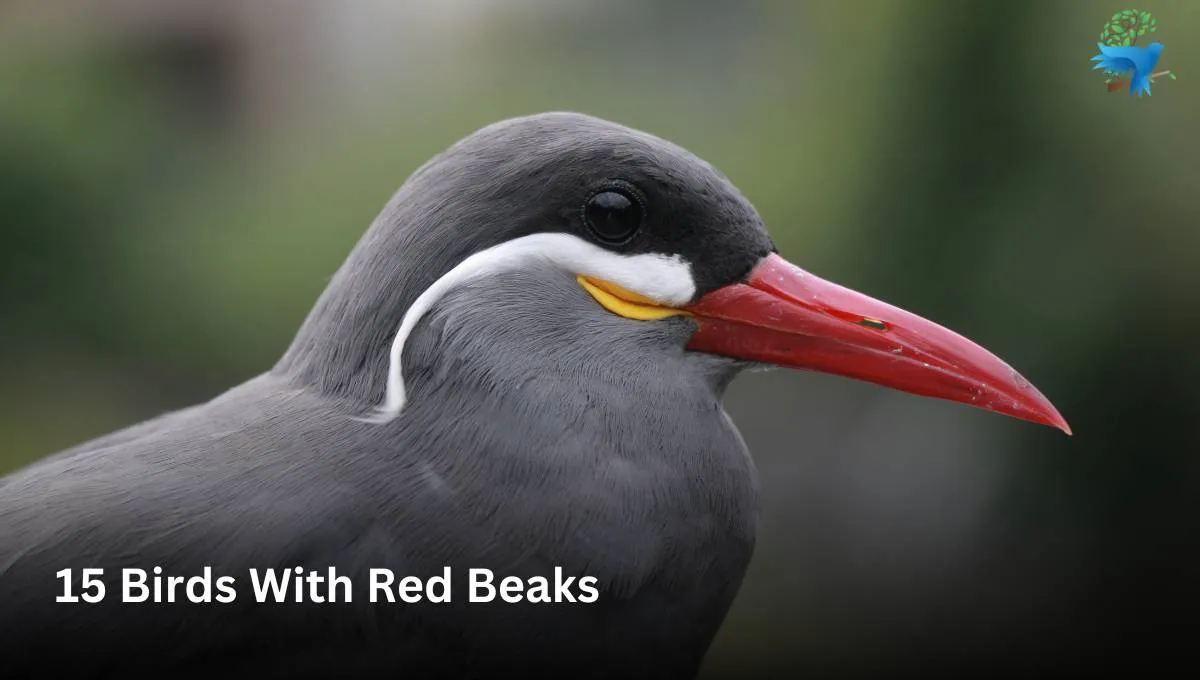
If you are an avid bird watcher, then you have come to the right place. One of the most distinctive characteristics of birds with red beaks is carotenoid pigment.
This concentration of pigment is responsible for the red coloration of beaks. Primarily, the beak coloration of the bird mostly depends upon their diet and hormonal balance.
Researchers have made significant discoveries related to a gene in birds. It helps to obtain an enzyme from their diet. Subsequently, it aids in the transformation of the yellow pigments into red pigments.
Let us delve into this blog post to explore more about the top 15 fascinating birds with red beaks found in this avian diversity. Stick with us til the end of this article for an enriching journey into the world of bird diversity.
List of 15 Birds with Red Beaks
- Green wood hoope
- Red-headed lovebird
- Black stork
- Keel-billed Toucan
- Wood duck
- White Ibis
- Red-browed finch
- Black Swan
- Oystercatcher
- Red-billed leiothrix
- Common merganser
- Broad-billed hummingbird
- Tufted puffin
- Red-billed chough
- Common waxbill
1. Green wood hoopoe (Phoeniculus purpureus)
Description:
It is a large bird which was formerly called the red-billed wood hoopoe. This species of bird has a long thin curved red bill, a metallic dark green body, and a diamond-shaped long purple tail.
Male and female birds have similar types of bills but, the immature birds have black bills. Green wood hoopoe belongs to the family of Phoeniculidae.
This bird is 17 inches long or 44 cm long. It is considered to be one of the five species of the genus Phoeniculus.
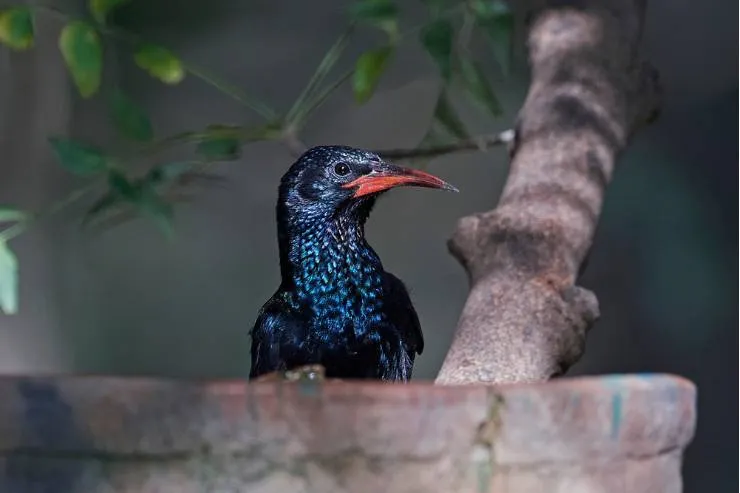
Habitat:
Green wood hoopoe is a large bird that is most native to the country, Africa. This kind of species of bird is a common resident in the woodlands, suburban gardens, and forests of sub-Saharan Africa.
Feeding:
This type of abundant bird, the Green wood hoopoe diet mainly consists of a variety of insects. Mostly, they forage on the ground or at the tree trunks.
2. Red-headed lovebird (Agapornis pullarius)
Description:
The red-headed lovebird also known as the lovebirds belongs to the genus of Agapornis. Besides this, they are also called the red-faced lovebird. It is a long bird which is mostly similar to the green parrot.
This lovebird has a red area where it extends from the top of the beak to the right and left eyelid. They have light green underside of the wings and grey feet.
While recognizing the beaks of both sexes, the adult male has a red beak whereas the adult female has a paler red.
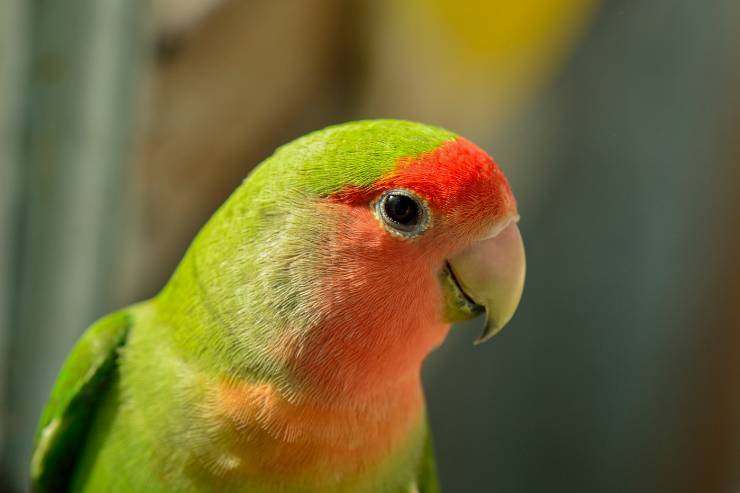
Size and Weight of Red-headed Lovebird:
- Size: 6 inches (15 cm)
- Weight: 1.5 ounces (43 g)
Habitat:
The red-headed lovebird is now native to Africa. These birds are widely distributed across the African tropical rainforest.
Feeding:
Primarily, their diet consists of a wide range of fruits, grass seeds, and cultivated crops. Apart from this, they also eat insect larvae.
3. Black stork (Ciconia nigra)
Description:
The black stork is scientifically known as Ciconia nigra. This is a large bird that belongs to the family of Ciconiidae. Generally, the black stork is characterized by their long, straight, pointed red beaks.
Under this species of bird, both male and female storks have the same appearance. While the male storks are larger as compared to female storks. These birds have a long neck and long red legs.
Their plumage is black while the lower parts like the breast, belly, under the tail, and axillaries are white. They also have brown irises and long and shaggy breast feathers.
The black stork birds fly with their necks outstretched. Like other storks, these birds also walk slowly and steadily on the ground.
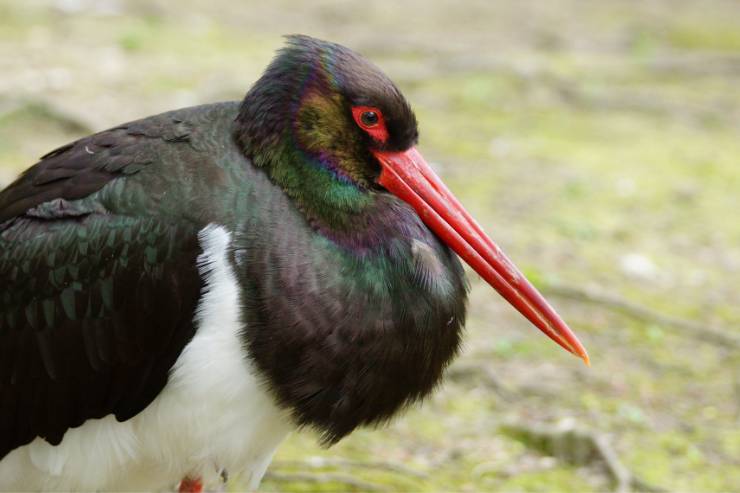
Size, Weight, and Wingspan of Black Stork:
- Size: 37 and 39 inches (95 and 100 cm)
- Weight: 6.6 lbs (3 kg)
- Wingspan: 57-to-61 inches (145-to-155 cm)
Habitat:
Being a migratory bird, they are commonly found from Eastern Asia to Central Europe. Also in some places like Poland, Czech Republic, Italy, Bavaria, and Lower Saxony in Germany.
Black storks are widely distributed across Europe and some parts of Asian countries. Most of the black storks prefer wooded areas, marshy wetlands with interspersed broadleaved woodlands, or coniferous woodlands.
Feeding:
Their diets consist of small reptiles, a variety of invertebrates, amphibians, birds, mammals, and crabs.
4. Keel-billed toucan (Ramphastos sulfuratus)
Description:
The keel-billed toucan is regarded as the national bird of Belize. This beautiful bird has a colorful bill which is mainly green in color with a red tip and orange in sides.
These birds are also known as keel toucan, sulfur-breasted toucan, or rainbow-billed toucan. Typically, their striking appearance makes the keel toucan a more fascinating bird.
Their plumage is black with a yellow chest and neck. They have zygodactyl feet which help them to sit on the tree branches. In addition, two toes facing forward and two facing backward also help to jump from one branch of the tree to another.
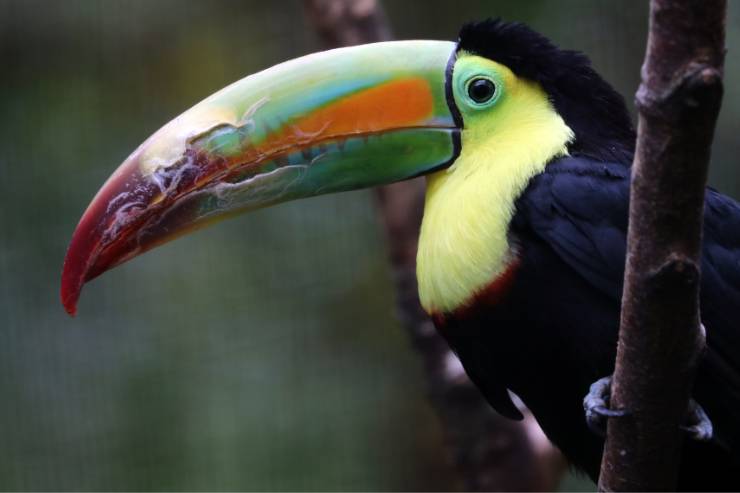
Size, Weight, and Bill Length of Keel-billed toucan:
- Size: 17 to 22 inches (42 to 55 cm)
- Weight: 13–18 ounces (380–500 g)
- Bill Length: 4.7–5.9 inches (12–15 cm)
Habitat:
These charismatic birds are found in tropical, subtropical, and lowland rainforests. Commonly, the keel-billed toucan is often observed in Southern Mexico, Venezuela, and Colombia.
Feeding:
Primarily, this bird feeds on a wide range of fruits, eggs, nestlings, lizards, and insects. The rainbow-billed toucan consumes their food with the use of its bill.
5. Wood duck (Aix sponsa)
Description:
The wood duck is also known as the Carolina duck. It is a medium-sized perching duck that belongs to the family Anatidae. Both male and female ducks have crested heads.
A species of male duck that has distinctive multicolored iridescent plumage. Adult males have red eyes with a white flare on their necks.
Whereas, females have a white throat, white eye patch, iridescent blue-green speculum, and a white border on the tail. Among the ducks, they have a unique appearance.
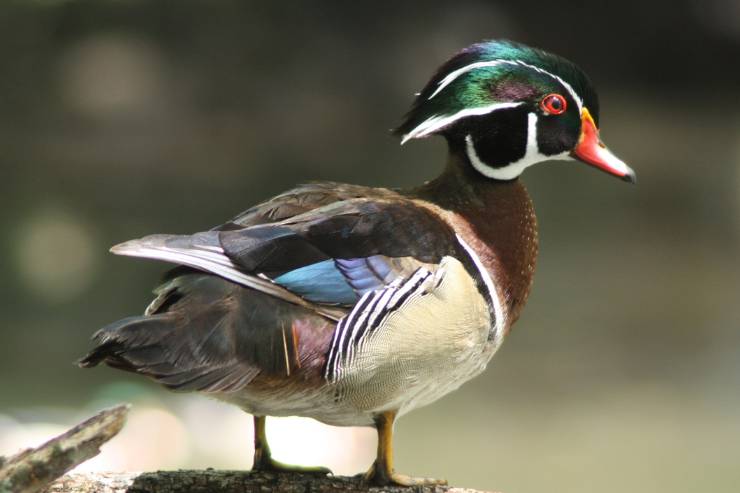
Size, Weight, and Wingspan of Wood Duck:
- Size: 19 to 21 inches (47 to 54 cm)
- Weight: 16.0–30.4 ounces (454–862 g)
- Wingspan: 26 and 29 inches (66 and 73 cm)
Habitat:
It is recognized as one of the most beautiful colorful birds found in North American waterfowl. These birds are residents in some parts of the southern range and vagrants in Western Europe.
They live in marshes, ponds, shallow lakes, swamps, and creeks. Most of the time this stunning duck i.e. Wood duck can be observed in the eastern United States, southern Canada, and west coast of Mexico.
Feeding:
Primarily, the Wood duck feeds on seeds, berries, acorns, and insects.
6. American white Ibis (Eudocimus albus)
Description:
The American white ibis is a medium-sized bird found in Virginia via the Gulf Coast of the United States. At the time of birth, the American white ibis bill is short and straight.
Overall, this bird has white plumage, a long downcurved red bill, and bright red-orange long feet. Particularly, male ibis have larger and longer bills compared to female ibis.
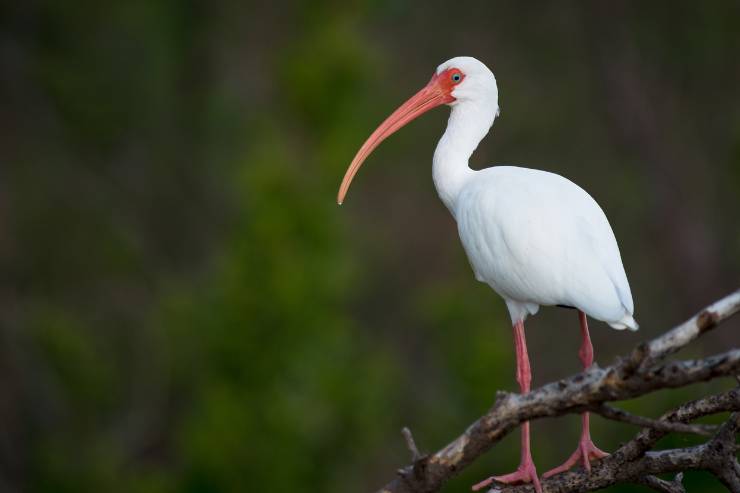
Size, Weight, and Wingspan of American white ibis:
- Size: 21 to 28 inches (53 to 70 cm)
- Weight of male: 1.924 to 2.780 lbs (72.9 to 1,261 g)
- Weight of female: 1.307 to 1.899 lbs (592.7 to 861.3 g)
- Wingspan: 35 to 41 inches (90 to 105 cm)
Habitat:
A species of bird belonging to the Ibis family, the American white ibis is commonly found in Florida. Throughout the year, they are seen across the coastal New World tropics.
Their habitat is mainly preferred to shallow coastal marshes, mangrove swamps, and wetlands. This bird is also found in muddy pools, wet lawns, and mudflats.
During the breeding season, white ibis often migrate along the Atlantic coast, from Carolinas south to Florida. Thus, ibis finally reaches to west along the Gulf Coast.
Feeding:
They mainly consume small fish, crustaceans, aquatic insects, crayfish, and frogs. White ibis catch their prey slowly, once if bill is located. They forage nearby saltwater areas and freshwater wetlands.
7. Red-browed finch (Neochmia temporalis)
Description:
Scientifically, the Red-browed finch bird is known as Neochmia temporalis. They are also commonly known as aviary birds belonging to the family of Estrilididae.
Regarding its physical features, this species has a bright red rump, a small pointed red beak, and a bright red stripe above the eyes.
This bird has olive green upper parts with grey underneath and does not have red brow marks and wing coverts.
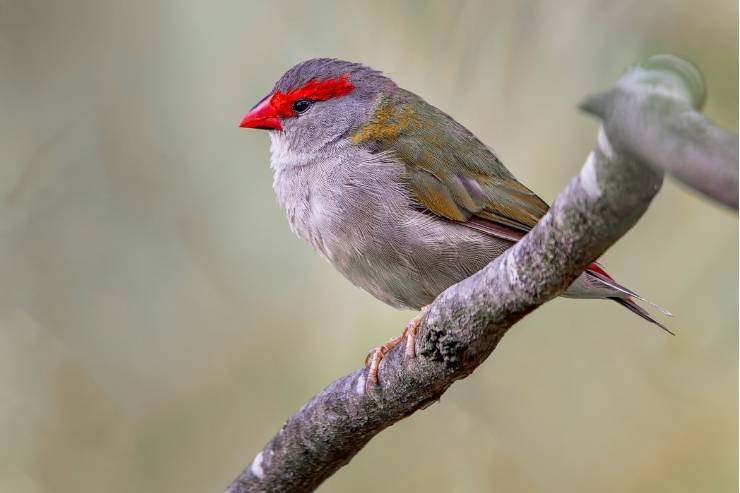
Habitat:
These birds are highly sociable. Red-browed finch birds with red beaks are often found on the edges of forests, near creeks, in semi-open woodland, and in dry savannah habitats.
Feeding:
Primarily, their diet consists of seeds and insects on the ground.
8. Black Swan (Cygnus atratus)
Description:
The black swan is a large waterbird that has a bright red bill with a white pale bar and tip. These species of swan have black plumage with white flight feathers and greyish-black legs and feet.
These fascinating cobs (males) are slightly larger as compared to pens (females). Being a largely monogamous breeder this waterbird needs both sexes to share incubation and cygnet-rearing duties.
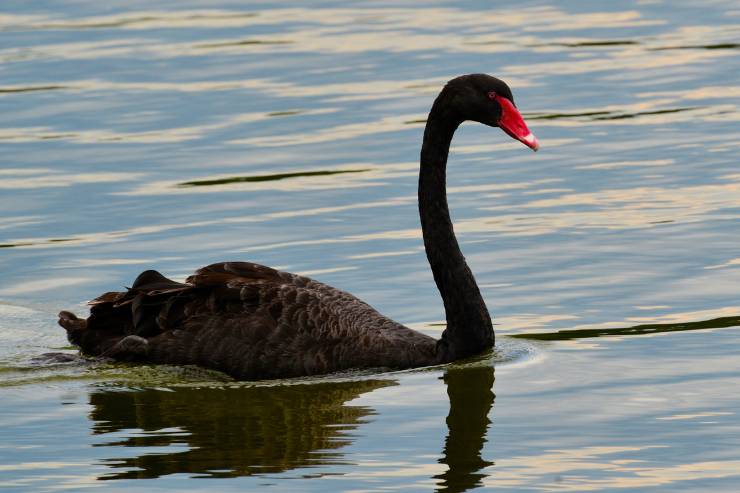
Size, Weight, and Wingspan of Black Swan:
- Size: 43 and 56 inches (110 and 142 centimeters)
- Weight: 8.2–19.8 lbs (3.7–9 kilograms)
- Wingspan: 5.2 and 6.6 ft (1.6 and 2 meters)
Habitat:
Throughout the year, Black swans are found in the southeast and southwest of Australia and Tasmania. However, these birds are uncommon in the northern and central parts of Australia.
In the 1800s, this charismatic bird was introduced as an ornamental bird in various countries. While looking at the black swan, is recognized as a popular bird in the zoological gardens and as well as a collection of birds.
Besides these places, their relative species of swan are also found in mainland China, Florida, Japan, the United Kingdom, and New Zealand. They prefer to habitat in shallow lakes, swamps, and ponds.
Feeding:
Mostly, these elegant black swans are herbivorous and feed both in the water and pasture land. Their main diet consists of submerged algae and aquatic plants.
9. Oystercatcher
Description:
It is a bird that has a single genus Haematopus which was named by a Swedish naturalist, Carl Linnaeus in 1758. They belong to the family of Haematopodidae.
One of the most distinctive features of oystercatcher is its massive long orange or red bills. They use their bills to prey on the open mollusks.
These birds are large, stocky, white underneath, noisy plover-like birds, and reddish-pink legs. Oystercatchers are sexually dimorphism. It is a condition where sexes of the same species exhibit different morphological characteristics.
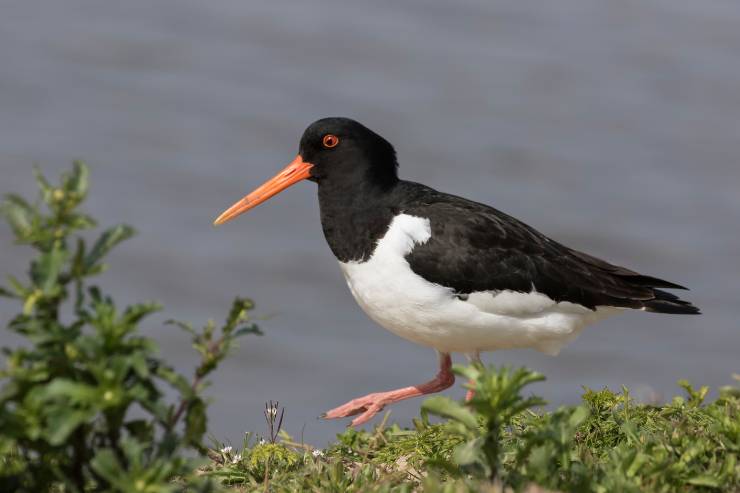
Size, Weight, and Wingspan of Oystercatcher :
- Size: 15.5-19.5 inches (39–50 centimeters)
- Weight: 465-640 g
- Wingspan: 28.5-36 inches (72–91 cm)
Habitat:
Oystercatcher is well-adapted in some parts of the tropical regions such as South East Asia and Africa. Commonly, these groups of waders belonging to the Haematopodidae family are found in coastal habitats worldwide.
There are certain exceptions where these birds can be found like South Island oystercatcher, Eurasian oystercatcher, and Magellanic oystercatcher. They breed inland and far inland in some of the cases.
Feeding:
The Oystercatcher mainly feeds on insect larvae and earthworms. But, there are 12 species of Oystercatcher and their diet mostly depends upon the location.
During the coast type of coastal oystercatchers, they eat gastropods, polychaete worms, and bivalves. While the rocky shore oystercatchers eat chitons, mussels, limpets, and gastropods.
All types of oystercatchers are monogamous except Eurasian oystercatchers. Beyond this, they also consume fish, crabs, and echinoderms.
10. Red-billed leiothrix (Leiothrix lutea)
Description:
Generally, the red-billed leiothrix is a small bird that has a yellow throat with orange shading on the breast. While the adult male has pointed bright red bills with a yellow dull ring near the eyes.
Their colorful forked tail is olive-brown and the bright feathers are a mix color of orange, yellow, and red.
Moreover, the female birds are somewhat dull as compared to the male birds. Along with that, they lack a red patch on the wings. Their length is about six inches.
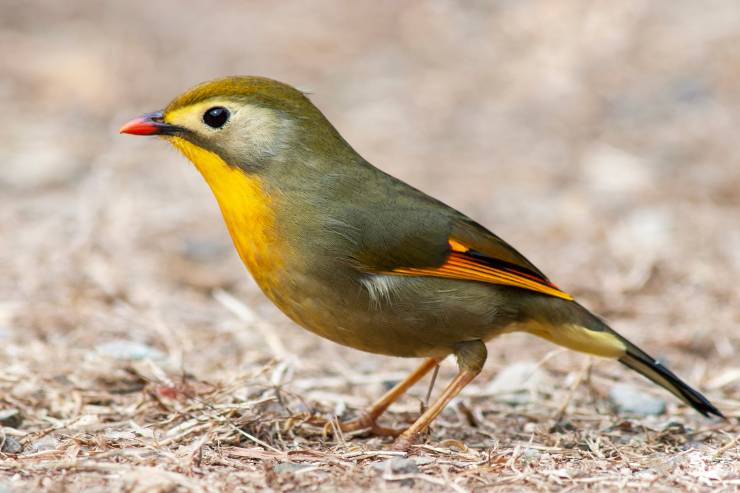
Habitat:
The highly socially active bird, red-billed leiothrix is found in southern China and the Himalayas. Some of the common places are Bhutan, Nepal, India, some parts of Tibet, and Burma.
This species of fascinating bird is also introduced in the Hawaiian Islands, southern England, and widely distributed in Spain from Collserola Park.
This bird permanently resides in Forest Hill, jungle areas, and pine forests with bushes.
Feeding:
Typically, this bird gathers their daily requirement of food from foliage and dead wood. Mostly, the red-billed leiothrix also known as Leiothrix lutea mainly feeds on animal matter.
Perhaps, the birds also eat various species of insects (like Lepidoptera, Mollusca, Diptera), and fruits (ripened papayas, guava, and strawberries).
11. Common merganser (Mergus merganser)
Description:
These birds, Common merganser are also known as goosander. It is recognized as one of the largest sea ducks which has a crest of longer head feathers.
Their straight and narrow bills are red to brownish-red with a short black-edged white stripe between the eye and bills.
During the breeding season, the plumage of adult males is easily identified with a white body along with a variable salmon-pink tinge. Also, the rumps and tail are grey.
In like manner, the adult females during the non-breeding plumage, have reddish-brown heads. Their wings are white secondary feathers.
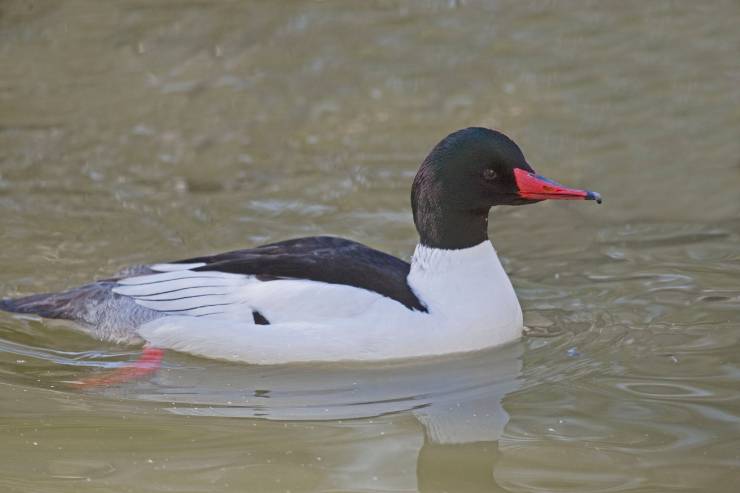
Size, Weight, and Wingspan of Common merganser:
- Size: 23–28.5 inches (58–72 cm)
- Weight: 2 lb 0 oz – 4 lb 10 oz (0.9–2.1 kg)
- Wingspan: 30.5 to 38 inches (78–97 cm)
Habitat:
Commonly, they are native birds to North America, some parts of Europe areas, and Asia. The common merganser can be often seen in freshwater or salt water.
These birds are similar to ducks that can float gracefully with the stream for a few miles.
Feeding:
The common merganser primarily feeds on a wide range of aquatic prey. Some of them are insect larvae, crustaceans, mollusks, amphibians, and worms.
At the time of swimming in the upstream, they often can be spotted sitting in the rocks in midstream.
12. Broad-billed hummingbird (Cynanthus latirostris)
Description:
The broad-billed hummingbird is a diurnal bird that has a distinctive long bright red-colored bill with a black tip. In terms of the bill, the male hummingbird’s bill is shorter than the female hummingbird.
They display sexually dimorphic traits which might vary with adult birds. Overall, the male bird’s body is dark green with a dull color on their forehead and crown. Their tail is white-tipped.
While the female has white eyestripes behind the eye and along with a pale belly color.
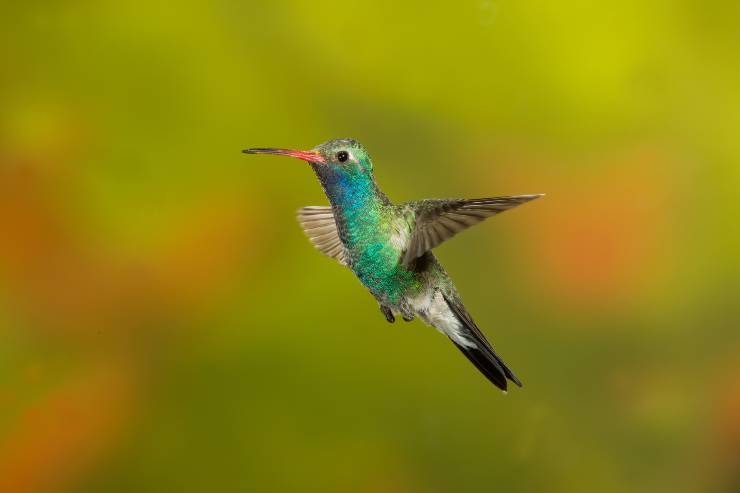
Size, Weight, and Wingspan of Broad-billed Hummingbird:
- Size: 3.1–3.9 inches (8–10 cm)
- Weight: 3–4 grams
- Wingspan: 5.1 inches (13 cm)
Habitat:
These small hummingbirds are found in open areas. Such as oak woodlands, low mountainous regions, and areas with dense vegetation.
It is regarded as the resident bird in tropical deciduous forests, arid thorn forests, and riparian gallery forests. They can be easily observed in the states of Sonora and Mexico but, rarely in the continent, of Arkansas.
Feeding:
Their feeding habitat is closely monitored which concludes that broad-billed hummingbirds mostly prefer to visit red or red-and-yellow flowers.
Both insects and nectar are consumed by these birds. In the absence of insects, it was seen eating flying Ephemeroptera and Diptera.
13. Tufted puffin (Fratercula cirrhata)
Description:
A medium-sized pelagic seabird, the tufted puffin is easily recognized with its thick red bill and yellow tufts. It has enormous bills that help to regulate their body temperature and also to hold more fish in the mouth.
The bill colored of tufted puffins changes throughout the year. This results due to an increase in the size of their beaks as they mature. They have a black body shape with a white facial patch.
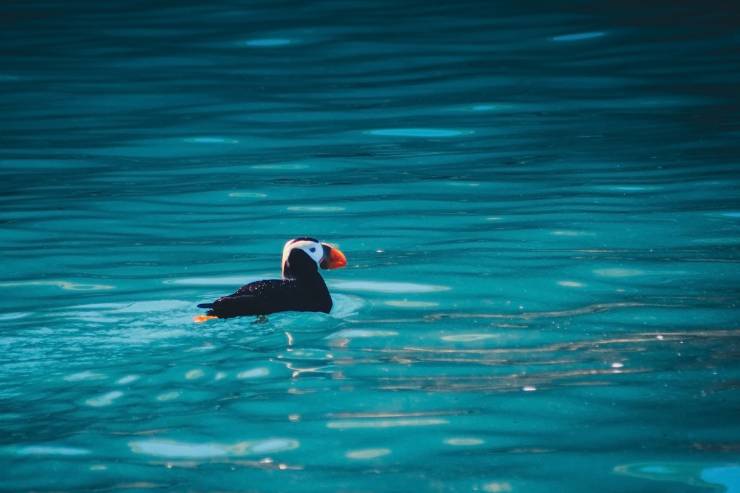
Size, Weight, and Wingspan of Tufted Puffin:
- Size: 14 inches (35 cm)
- Weight: 1.6 lbs
- Wingspan: 63-74 cm (24.8 to 29.1 inches)
Habitat:
Primarily, their habitat is soft soil substrate and grass. During the summer season, puffins are spotted in Washington state, southeastern Alaska, British Columbia, and Kuril Islands.
During the winter season, they extend their range from the North Pacific and south to Japan and California.
Feeding:
The tufted puffin diet varies according to their age and location. It feeds on a variety of fish, marine invertebrates, and sand lance.
14. Red-billed chough (Pyrrhocorax pyrrhocorax)
Description:
The scientific name of red-billed chough is Pyrrhocorax pyrrhocorax. It belongs to the family of Corvidae which has significant physical characteristics.
It is a bird that has a long curved red bill along with black velvet plumage and its body is green-glossed. This bird is also known as cornish chough or chough.
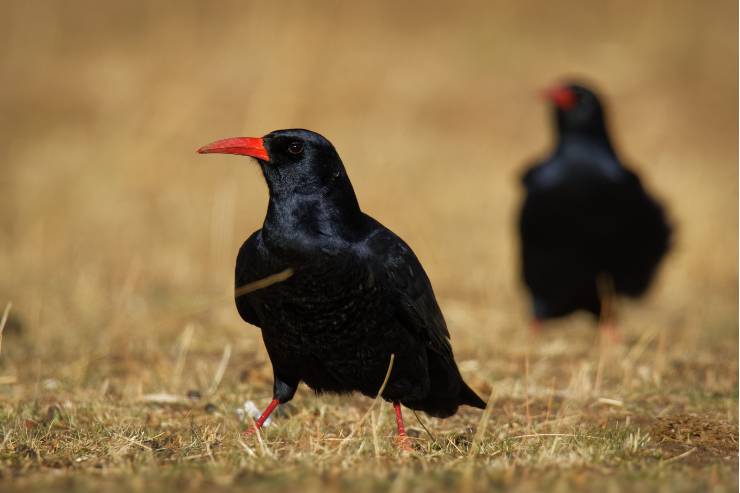
Size, Weight, and Wingspan of Red-billed chough:
- Size: 15–16 inches (39–40 cm)
- Weight: 10.9 oz (310 g)
- Wingspan: 29–35 inches (73–90 cm)
Habitat:
The red-billed chough is a non-migratory resident bird. Their breeding habitat ranges from the Isle of Man, the Mediterranean basin, Ireland, the Alps, and North Africa.
Feeding:
This bird mostly feeds in flocks during the winter season in the Himalayas. They are insectivorous. Their diet consists of insects, ants, and spiders. It uses bills to dig for invertebrates and bulbs.
15. Common waxbill (Estrilda astrild)
Description:
The common waxbill is a small passerine bird that belongs to the family Estrildidae. The adult bird has a bright red bill that seems the color of sealing wax and their plumage is grey-brown with dark brown.
Their underparts are pinkish and the belly part has a reddish stripe in the center. While the females are less in pale color than compared to male waxbills.
This bird has distinctive twittering and buzzing calls with a high-pitched flight call. Being a small bird, they are popular for easily keeping their captivity.
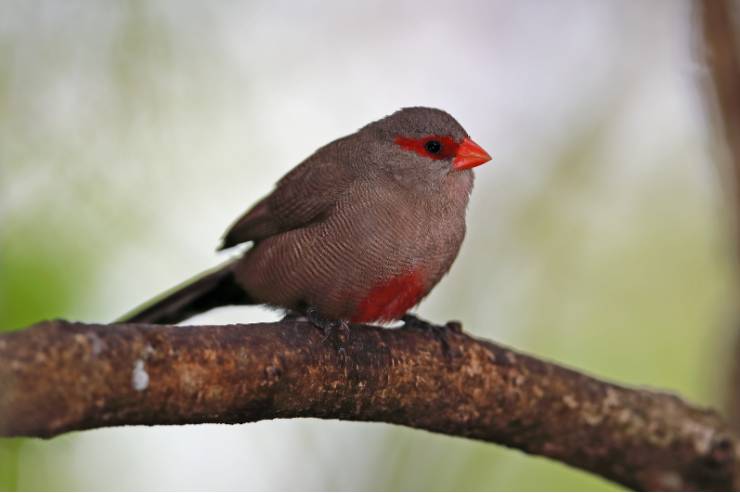
Size, Weight, and Wingspan of Common Waxbill:
- Size: 4 to 5 inches
- Weight: 3/5 to 3/4 ounce
- Wingspan: 4.5 inches
Habitat:
The common waxbill also known as the St Helena waxbill. It is widely distributed throughout sub-Saharan Africa in the east, central, and southern parts.
These birds are found in the marshes near water, reeds, parks, backyards, gardens, and farmlands. They inhabit mostly in open areas with long grass.
Feeding:
This species of bird eats grass and millet seeds. Occasionally, they consume insects when common waxbills require more protein in their body during the breeding season.
The sources of their diet include crabgrass, guinea grasses, and Echinochloa species.
Conclusion:
The stunning birds with red beaks showcase diverse physical traits, behaviors, habitats, and diets. It makes these birds the fascinating subjects of study.
One of their most remarkable features is their widespread distribution across various regions of the world. With their vibrant presence, these red-beak-colored birds add beauty to nature in the avian world.






